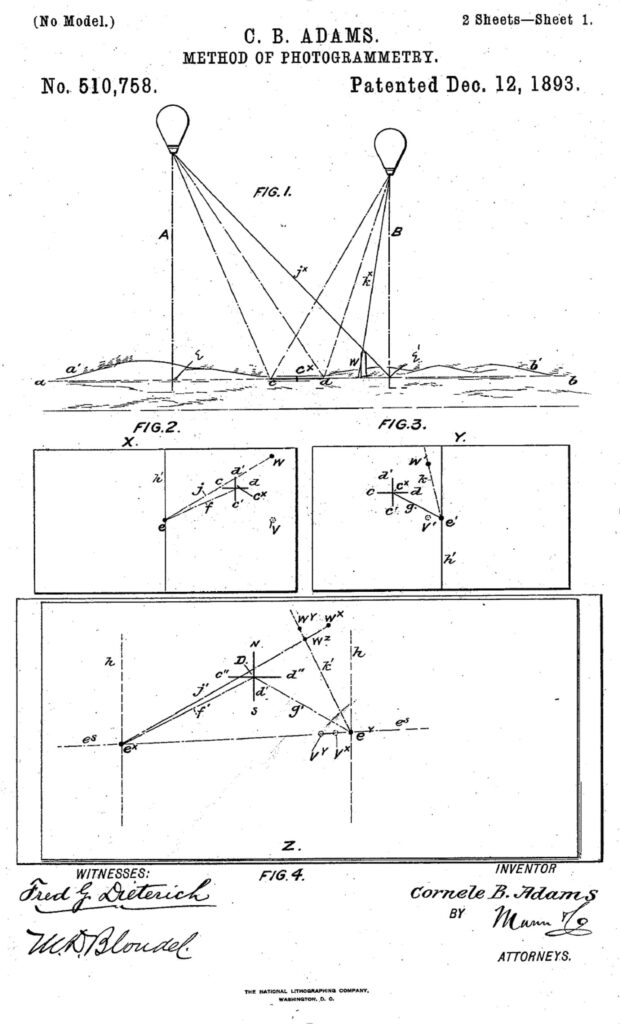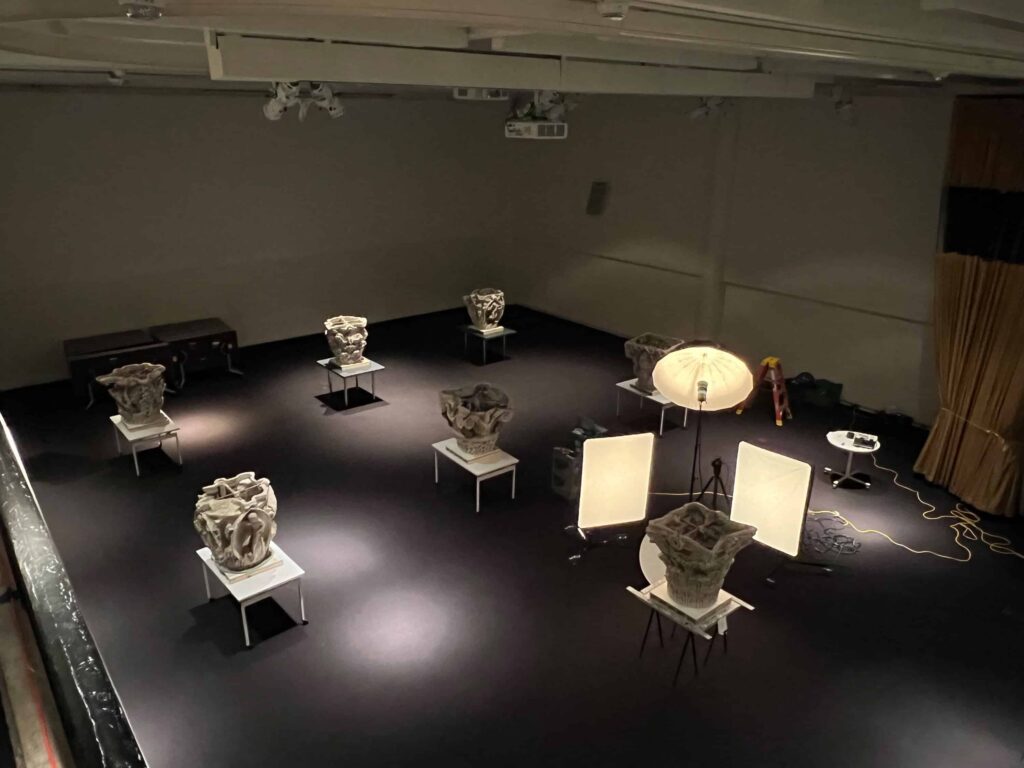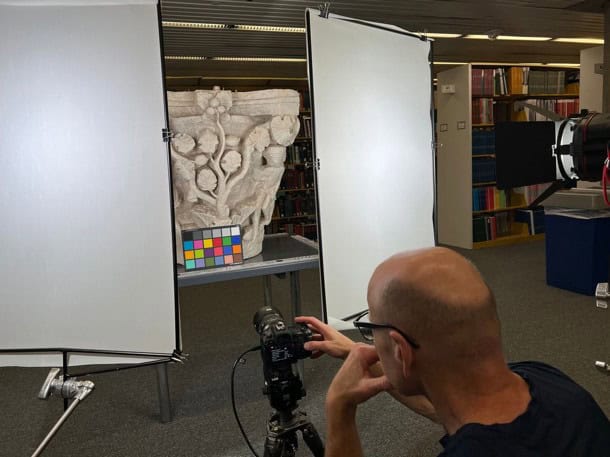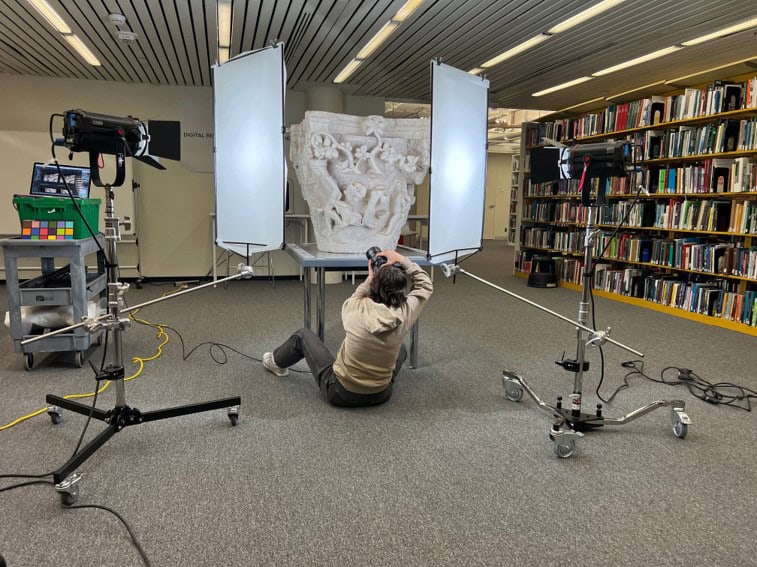Rebuilding Cluny: Digital Experiments with Medieval Architecture
Text by Matthew Cook, Digital Scholarship Programs Manager, Widener Library
In the 2022-23 academic year, Harvard Library partnered with Professor Christine Smith to digitize eight full-scale capital facsimiles (casts) representing originals that once encircled the church apse at the medieval monastery at Cluny. Harvard Library Imaging Services utilized the photogrammetric scanning method to produce the models as part of their new 3D scanning-on-demand service, developed to support remote teaching and learning during the pandemic.
Photogrammetry itself was developed mid-19th century, for surveying, mapmaking, and military purposes. Contemporary processing techniques stitch multiple, overlapping photographs taken from systematic positions to generate detailed 3D models of objects, landscapes, and architectural features. Remarkably accessible compared to other 3D capture technologies, such as LiDAR or MicroCT scanning, photogrammetry has become a preferred tool for academic departments and cultural institutions on a budget and represent a cornerstone in the democratization of digital preservation and an essential link between the tangible past and the digital future.
Importantly, requestors must be able to communicate how academically relevant features are spread across three spatial dimensions of their object before Harvard Library will undertake a scanning project. In the case of the Cluny Capitals, justification was clear: In addition to the inherent dimensionality of the individual capitals (each of which features detailed iconography on 4 faces and 4 angles); and surface material qualities that support evaluation across varying viewing distances, angles, and lighting conditions; the 3D scanning allows the 8 capital scans to be re-positioned relative to one another, virtually reproducing the Cluny apse at human scale. Such scientifically rigorous 3D scanning techniques have profound implications. These high-resolution, photorealistic representations of real-world objects allow students and scholars to engage with surrogates as they would with objects in the field; from novel perspectives, but with the added benefit of allowing physically impossible analyses and asynchronous, remote access. Further, immersive (i.e. XR) environments populated with these contents will allow scholars to view objects in context, alongside distributed networks of colleagues and students.
3d models of the capitals
Cluny Capital 01 is a Corinthian capital.
3D digital surrogate by Harvard Library Imaging Services
Photogrammetric scan based on cast from the Cluny Collection. Courtesy of Frances Loeb Library, Harvard University Graduate School of Design.
Cluny Capital 02 depicts four figures on the angles, perhaps representing the four seasons: The figure with the cloak who holds a book may represent Winter; the figure with a short tunic with its right arm raised, potentially sowing seed, may represent Spring; the nude figure may represent Summer; and the figure with a large fur glove, perhaps a falconer, may represent Fall.
3D digital surrogate by Harvard Library Imaging Services
Photogrammetric scan based on cast from the Cluny Collection. Courtesy of Frances Loeb Library, Harvard University Graduate School of Design.
Cluny Capital 03 depicts four figures on the angles which may represent the four winds (north, south, east, west). Only the lower parts of the figures remain on 2, 4, and 8.
3D digital surrogate by Harvard Library Imaging Services
Photogrammetric scan based on cast from the Cluny Collection. Courtesy of Frances Loeb Library, Harvard University Graduate School of Design.
Cluny Capital 04 depicts four standing figures in hexagonal mandorlas which represent the three Theological Virtues (Faith, Hope, and Charity) and the one Cardinal Virtue (Justice). Only one foot remains, but the silhouette shows: a figure holding something on a vertical cord, perhaps the scales of justice; a woman with an open coffer, representing Charity; a woman with her legs bent and hands out, maybe in prayer, representing Faith; and a woman holding a flowering baton, representing Hope.
3D digital surrogate by Harvard Library Imaging Services
Photogrammetric scan based on cast from the Cluny Collection. Courtesy of Frances Loeb Library, Harvard University Graduate School of Design.
Cluny Capital 05 depicts four standing figures in mandorlas, three of which have carved inscriptions and may represent the three Cardinal Virtues: Prudence, Temperance, Fortitude, one Liberal Art, and Grammar. However, these identifications do not match the inscriptions, which are: Summer, Spring, and Prudence (which is a painted, not carved, inscription).
3D digital surrogate by Harvard Library Imaging Services
Photogrammetric scan based on cast from the Cluny Collection. Courtesy of Frances Loeb Library, Harvard University Graduate School of Design.
Cluny Capital 06 depicts four plans on the main faces: an apple tree, fig tree, almond tree, grape vine. The four Rivers of Paradise (Physon, Geon, Tigris, and Euphrates) are on the angles.
3D digital surrogate by Harvard Library Imaging Services
Photogrammetric scan based on cast from the Cluny Collection. Courtesy of Frances Loeb Library, Harvard University Graduate School of Design.
Cluny Capital 07 depicts figures in inscribed mandorlas which represent the first four tones of plainchant. Tone 1 is represented by a seated man playing a lute, tone 2 is represented by a woman with cymbals or castanets, tone 3 is represented by a bearded man playing a stringed instruments, and tone 4 is represented by a young man with a tintinnabulum.
3D digital surrogate by Harvard Library Imaging Services
Photogrammetric scan based on cast from the Cluny Collection. Courtesy of Frances Loeb Library, Harvard University Graduate School of Design.
Cluny Capital 08 depicts the last four tones of plainchant on the angles. Only the legs remain of the figures at 2 and 8: for these, Conant inserted plaster upper bodies. One figure is without his head, but his instrument, a monochord, zither, or dulcimer, remains. Another figure has a right arm and may be a horn or flute player, but the rest of his torso is gone. The subject of the capital is identified by the inscriptions on a horizontal band.
3D digital surrogate by Harvard Library Imaging Services
Photogrammetric scan based on cast from the Cluny Collection. Courtesy of Frances Loeb Library, Harvard University Graduate School of Design.
3d model and animation of the Bernward column
This over twelve-foot high bronze column of the early eleventh century bears twenty-eight scenes of the Ministry of Christ from his baptism in the Jordan River to the entry into Jerusalem. The narrative begins at the bottom and spirals up to the top: above would have been a paschal candle. The digital models can be manipulated to spin slowly, allowing you to follow along the story line, or you can click on any one of the number to learn the identification of the scene.
Bernward Column (ca. 1020–1030) from the Church of St. Michael, Hildesheim, Germany, ca. 1900
3D digital surrogate by Harvard Library Imaging Services
Photogrammetric scan based on Replica of the Harvard Art Museums/Busch-Reisinger Museum, BR30.34
Digital animation by Harvard Library.
This seven-minute digital animation (fig. 118) illustrates how the scholarly problems posed by the Cluny capitals can be demonstrated and investigated using 3D digital models to further the architectural understanding and interpretation of the capitals and apse.
Concept creator and script: Christine Smith, Robert C. and Marion K. Weinberg Professor of Architectural History, Harvard University Graduate School of Design; Video animation editing and voice: Clayton Scoble, Creative Technologies, Harvard Library; 3D Digital model of the Cluny apse: Matthew Cook, Digital Scholarship Programs Manager, Harvard College Library.

The Cluny Collection
Exhibition: Envisioning Cluny: Kenneth Conant and Representations of Medieval Architecture, 1872–2025
Curator: Christine Smith, Robert C. and Marion K. Weinberg Professor of Architectural History
Collaborators: Matthew Cook, Digital Scholarship Programs Manager, Widener Library; Ines Zalduendo, Special Collections Curator at the Frances Loeb Library, M.Arch ’95
Animation: Clayton Scoble, Media Lab Director, Lamont Library
Assistants: Kian Hosseinnia, M.Arch ’24; Hayley Eaves, Ph.D Candidate
Exhibition Design: Dan Borelli, Director of Exhibitions, GSD, M.Des ’12
Online Exhibition Design: Ashleigh Brady, Archival Collections Website Editor, M.Arch ’26



